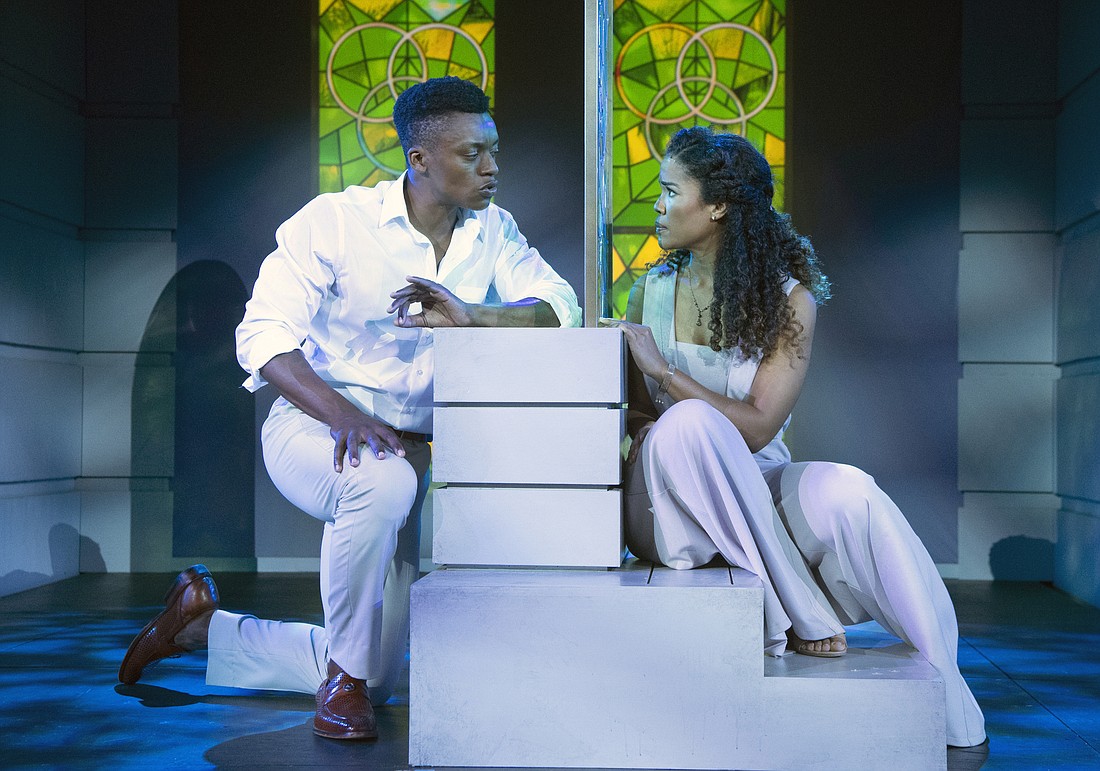- January 14, 2025
-
-
Loading

Loading

King Arthur’s Camelot is long-gone — if it ever existed at all. The musical “Camelot” is here to stay. And it’s currently running on the Asolo Rep’s safe, and socially distanced, outdoor Terrace Stage. This production is not your grandfather’s “Camelot.” So what is it? That’s complicated, but here goes…
This musical’s origin story is as tangled as a medieval family tree. Alan Lerner and Fred Loewe’s “Camelot” was an adaptation of T.H. White’s “The Once and Future King.” Along with “Pippin” and “The Fantasticks,”) was one of those early 1960s musicals that adapted (or invented) medieval legends and fairy tales. The joke they all shared? The characters talked in contemporary American speech with no “thees” or “thous.” Lerner and Lowe were definitely in on the joke. The dialogue between King Arthur and Guenevere could be lifted from a Jules Feiffer comic about a squabbling couple.
That’s all here at the Asolo Rep. But highly distilled.
David Lee (who had previously created a two-hour “Camelot”) and director Celine Rosenthal cut this material down to 90 minutes. Their adaptation trims away several characters (including Merlin) and subplots. The condensed result is a linear narrative with a tight focus on the love triangle between King Arthur, Lady Guenevere and Sir Lancelot.
Celine Rosenthal’s direction is intimate and highly personal. Traditional productions of “Camelot” tend to be grandiose, overblown and larger-than-life. This untraditional production is on a human scale. Rosenthal keeps the characters life-size.
Nick Duckart’s King Arthur approaches the situation with a “What, Me King?’ attitude. The man wasn’t raised to be a royal. As recounted in White’s novel, he got the job from pulling a sword out of a stone. He’s a newbie — and blithely attempts what the experts call impossible. Nothing less than create a perfect society in a fallen world.
As Lancelot, Joseph Grayson has powerful stage presence. His character is practically perfect in every way; it’s one of the musical’s running jokes. Lancelot could easily come off as a narcissistic goody-good. Grayson’s character is actually good, and that’s hard to pull off. Britney Coleman’s Guenevere is queasy about her queenly role from the get-go. She’s a bird in a gilded cage, and you can see why she wants to fly free. John Rapson, Joseph Torello and Levin Valayil do excellent work in various supporting roles. Rapson is especially effective as the smarmy, slandering scheming Mordred — Arthur’s illegitimate son, from a one-knight stand with a sorceress.
These actors perform in socially distanced style. No smooching, no smiting. It’s all done with mime and gesture, and they do it very well.
The story they tell comes to life with a six-piece band under Steve Orich’s musical direction; contemporary costume design by David Covach and Dee Sullivan; and state-of-the-art lighting by Ethan Vail and projections by Aaron Rhyme. (At one point, it looked like the FSU Center for the performing arts was going up in flames. It’s a wonder nobody called the fire department.)
This medieval minimalism works. It serves the story of Camelot after all. Distilling that story only makes it more powerful.
Strip away the flash and filigree. What you’re left with is a simple tale. King Arthur plans to turn Camelot into a Utopian society. His knights will all be equals, sitting around a Round Table with nobody at the head. When they’re not sitting down, his knights will ride around doing good deeds and not beating people up and taking their stuff. No more “might makes right.” Under Arthur’s rule, might will now serve what’s right! This works for a while — until Queen Guenevere (installed on the throne in an arranged marriage) takes a shine to Sir Lancelot. They resist temptation, for a while. Then Mordred, ratfink that he is, leads them into temptation and catches them in the act. After that, Arthur’s heavenly kingdom predictably goes to hell. Why “predictably” …?
Utopian societies have a short expiration date. They’re populated by imperfect human beings, after all.
Camelot inevitably falls. But the story of “Camelot” lives on.
In Lerner and Lowe’s stylized adaptation of White’s novel, it’s clearly a story. A tall tale. The product of a fabulist’s imagination. But rooted in something that actually happened …
The musical cleverly drives this home.
In the final battle, King Arthur meets Tom of Warrick — a peasant boy trying to sneak into the fight. Arthur tells the lad to hide, go home and write the story of Camelot. Tom is obviously Thomas Malory, the author of “Le Morte d’Arthur.” The man who wrote the legend of Camelot down in the first place.
In the end, the writer always gets the last word.